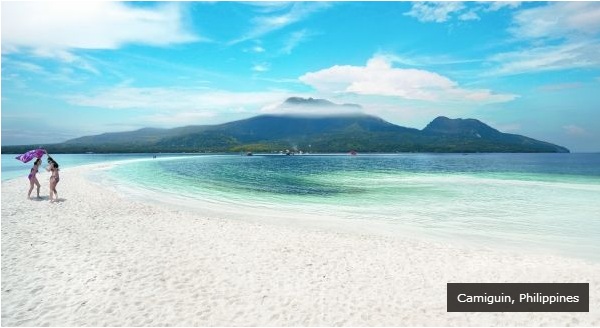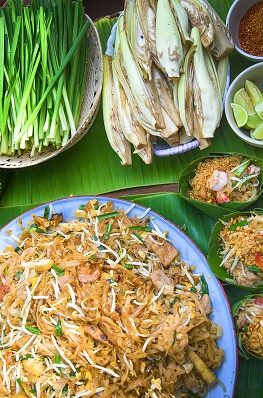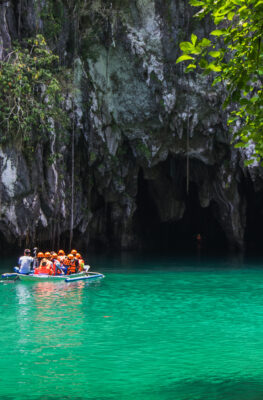Published on April 28, 2010

It is hard to imagine that the second smallest island in the Philippines has seven volcanoes, a few majestic waterfalls, pristine beaches, historical sites, and smaller islands surrounded by rich marine life and populated by genial island people. But here I am on a ferry heading to the Benoni Port, looking at the blue-ridged volcanic peaks of Camiguin that dominate the island’s landscape. I’ve heard much about this island naturally born and shaped by fire that it has captured my attention, even more when it was listed on Lonely Planet’s Bluelist for 2008 as a worldwide tourist attraction. I felt my excitement escalate and tugged on the handle of my backpack as we got closer to the island.
Finding your way
Benoni Port is the gateway of the island. If you intend to go around Camiguin, hiring a multi-cab for large groups or a habal-habal (modified motorcycle with driver) for small groups is recommended. Don’t get too excited on immediately hopping onto one as prices vary from driver to driver. Some would even suggest a “tourist” itinerary wherein the driver/guide would tour you around the island’s popular sites in one day.
Make sure you clarify your destination, routes and most importantly, the rate before riding. A quote of over Php2,000 is simply too much as Camiguin Island is small and can be circled in less than a day. Just make sure to stop and enjoy the sights of the rustic coastal communities.
Feeling at home
If you want to be near most of the island’s attractions, lodge at the Secret Cove Resort (http://www.secretcovecamiguin.com; rates start at Php850). While basic in terms of facilities, it is located across White Island. Johnny’s Dive Shop has also turned it into a popular destination among divers. Just outside the resort, there are a number of stores and eateries for food and basic supplies. The public market is just nearby where a number of habal-habals can also be hired.
Within walking distance from the Benoni Port, you can stay at the Islet Resort (tel. +6388 387 4005; mobile no. +63916 365 3966; rates start at Php700 duringoff peak season) in San Roque, Mahinog. We got a good price there for very basic accommodations. They also have habal-habal services.
Enjoying the sights
Most of Camiguin’s popular sights are accessible via the main road. Katibawasan Falls can be found northeast at the center of Mambajao. The place has been developed into a park, complete with cottages for a fee of only Php10. The falls has a narrow and silky cascade towering up to 250 feet and a pool-like basin. Nearby, there are optional stops like the Old Vulcan where pilgrimages to the stations of the cross are held every Holy Week.
From northeast, go to the western tip of the island at Barrio Bonbon where the Sunken Cemetery can be found. Sunset is the most dramatic time of the day to visit this site. A huge cross can be found just off shore marking the location of the old community cemetery which sank in 1871 when Mt. Hibok-Hibok erupted. There are boats to ferry people to the cross. Some even snorkel to check out the submerged tombstones.
Optional stop in town is the Catarman Church Ruins, which was wiped out by an earthquake during the same time when the cemetery sunk. Just off the coast of Yumbing is White Island, the shape of which changes with the rising and falling of the tides. To get there, hire a boat at Johnny’s Dive Shop for Php500. The boat, which can accommodate four to six persons, can be arranged to wait or return at a designated time. Gone are the huts of sellers from years past following a recent ordinance that banned infrastructures on this sandbar. This favorite place for daytrippers and snorkelers who want a pure unadulterated beach is now back to its almost pristine state.
Taking the off-the-beaten path
For those feeling a bit more adventurous, there are other sites in the island worth hiking and traveling to. Mantigue, a small island just off the coast of Benoni, is also a beach haven. The island geography is mostly made up of a wide and long stretch of white sand, while the inland forest is home to a number of bird species.
The less-explored Tuasan Falls can be found southwest of the island, in Barangay Mainit. The locals are adamant in having the rough trail converted into a road, preferring that the falls remain in its natural state. An hour’s hike is required to get to the falls but is well worth it. While not as high as Katibawasan, Tuasan has more pool layers, rocks, and dramatic cascades. It is best to visit here in the morning or late afternoon to avoid the hot, mid-day hike. Guides are recommended.
Tasting the local flavors
Exploring Camiguin may fill the eyes with wonder but the island can also fill your tummy with its sumptuous offerings. The Tanguines Lagoon, a causeway that connects the J&A Fishpen/Travel Lodge (tel. +6388 387 4008), a lodge-cum-floating restaurant to the sea, offers tasty seafood and other Filipino dishes along with refreshing views of the lagoon and the sea.
For those looking for comfort food, head to Rooftop (http://www.camiguin rooftophotel.com; tel. +6388 387 0511 to 13), located at the busy thoroughfare of Mambajao proper. A spanking new restaurant, hotel, and bar, it serves very good pizza and pasta. A bakeshop downstairs caters to sweet tooths.
Getting There
Ferries leaving for Camiguin Island’s Benoni Port start departing from Balingoan Port at 6 a.m., with hourly trips until 5 p.m. Travel time is about an hour. Regular fare is Php 135 while fare for the air-conditioned section is around Php 165. There is also a fast craft plying the Cagayan de Oro-Camiguin route. The fast craft leaves CDO port at 8:30 a.m. and arrives in Benoni Port at 10:30a.m. It leaves Benoni Port at 11:30 a.m. and arrives in CDO at 1:30p.m.
This article was provided by Philippine Airlines’ Mabuhay Magazine.Mabuhay Magazine is published by Eastgate Publishing Corporation (email:info@eastgatepublishing.com;website: http://www.eastgatepublishing.com).





